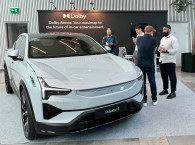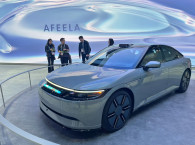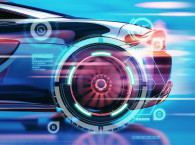Immersive and Energized
Over the course of three days and two nights, June 8–10, the Audio Engineering Society’s 2022 International Automotive Audio Conference in Dearborn, MI, served as a great event for everyone in the automotive audio community to reconnect.
After years of isolation and working remotely, the automotive audio community had a chance to catch up with old colleagues and discuss new ideas. As bright as an early summer day in southern Michigan, there was a great joy and a feeling of satisfaction to listen to music in a car again with someone who had created a unique system integration or the latest immersive algorithm, and then to talk about what would come next, or to experience unique testing and simulation methods.
At the end of the conference, attendees were reluctant to leave and some demos continued past the point of the exhibit hall being cleared out and readied for the next event. Everyone was already looking forward to the next conference in Europe, as if it couldn’t come soon enough.
These were the sentiments of the record-setting 200-plus attendees of what is always a very popular Audio Engineering Society (AES) conference (Photo 1). It is a conference where OEMs, Tier Ones, and independent suppliers and contractors can gather at one event to discover possibilities and solutions in a very specialized audio community. It engaged the attendees with 26 excellent technical papers in the program, and it also instructed with workshops and tutorials throughout. In parallel with the technical program, the AES’s Audio Product Education Institute (APEI) initiative provided a hands-on track, covering Voice DSP, Machine Learning, CAE Simulations, and Test and Measurement. And, for the first time, there was a free “Careers in Automotive Audio” event for any student who could make their way to the Dearborn Inn (Photo 2).

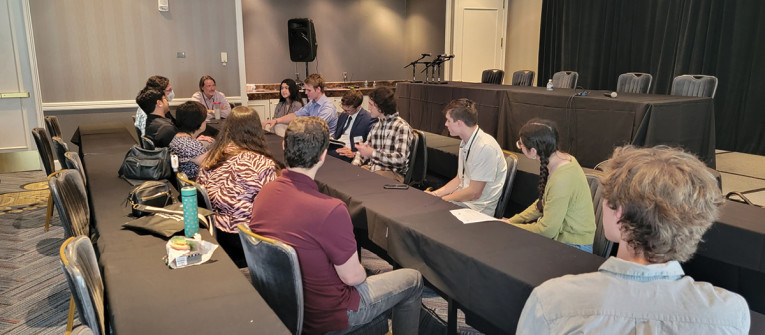
Concurrent with the technical programs and workshops, the 7,600 square foot ballroom was home to the exhibit’s hall for 16 sponsors with nine vehicles (Photo 3). There was also a showcase of the AES’s Technical Committee for Automotive Audio’s working group’s results on “Measurement Techniques in Vehicles,” which will be released as a white paper this fall (Photo 4).


It is no surprise that this community is so enthusiastic and the conference so popular. As one attendee was overheard to say, “The sound system in a person’s car is generally the best sound system they have.”
Coming together again in the largest group yet, the passion that drives this automotive audio community was on display and buzzing with excitement. From the industry veterans, newcomers, and students alike, no one could have been happier to be there and found it harder to let the time be over.
Just the Highlights
The conference opened with just the right keynote from Dr. Mathias Johansson, co-founder and Chief Product Officer of Dirac Research (Photo 5). Many automotive industry leaders talk of an on-going paradigm shift that resembles the disruptive change that the mobile phone industry underwent a decade ago. In his talk, Johansson discussed how this industry transformation has already increased the demand for high audio quality of in-car entertainment systems. He discussed the primary drivers, and what the demand and opportunities for higher audio quality means in practice.
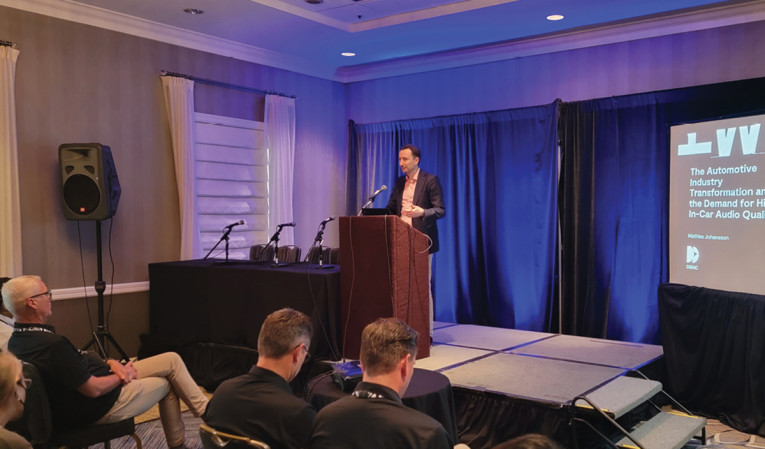
The first day focused on test and measurement techniques for enhanced perceptual Rub & Buzz from Listen, Inc., automatic head position detection and system adjustment from Panasonic (Photo 6), as well as in-vehicle control of nonlinear speaker behavior, from Klippel. The day also included presentations on automated control of reverberation level using a perceptional model, and object-based audio as a platform technology in vehicles, both from Fraunhofer (Photo 7), as well as a new stereo up-mix design for shaping sound experiences in automotive from Dirac Research (Photo 8). A comprehensive tutorial on position dependent amplitude response in automotive loudspeakers, with measurements to isolate or eliminate the causes of these audible anomalies, was presented at the end of the day to a full house, by Mark Ziemba from Panasonic (Photo 9).
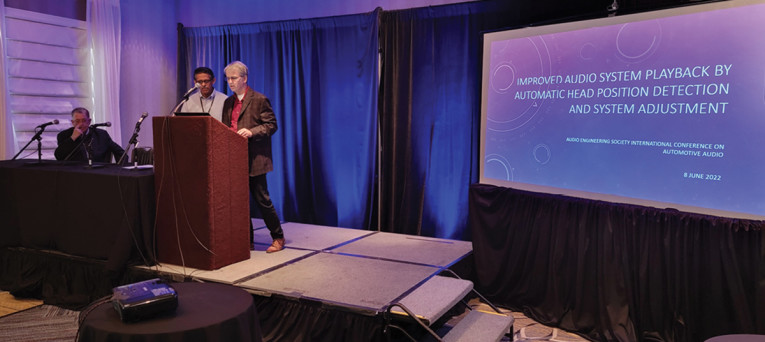
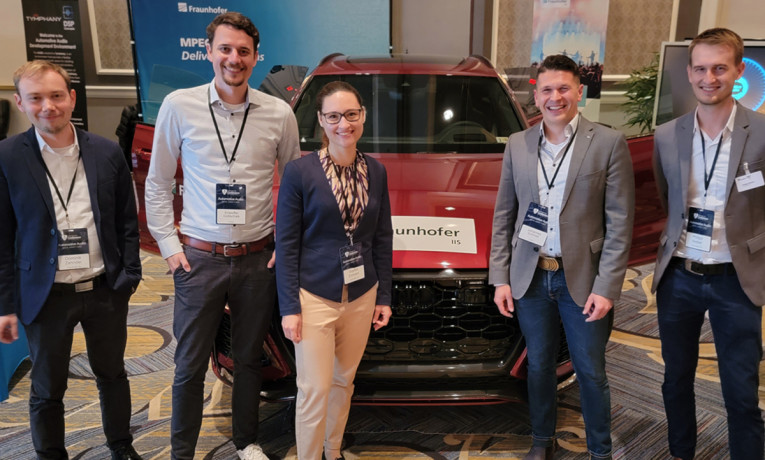
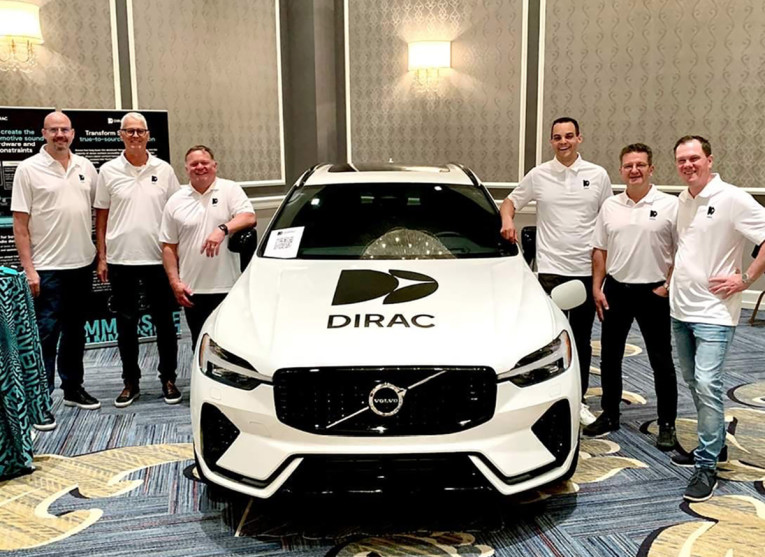

The second day was led off by Andreas Ehret (Photo 10), Director of Automotive at Dolby, whose keynote set the tone for the day on a trend in audio that is beginning to mature in Automotive: Immersive Audio — the topic that captivated the conference throughout. Content creation, playback technology, and consumer preferences all point toward the growing momentum of immersive audio in the consumer entertainment industry. The biggest question was: Is the automotive audio industry ready to embrace this revolution? The audio industry will face new opportunities and challenges for how to make immersive in-car entertainment technically possible across a growing number of use cases. There exists tremendous future potential for enabling these types of experiences, and by analyzing this topic, Dolby is helping to unlock what this revolution will mean for the industry and consumers.
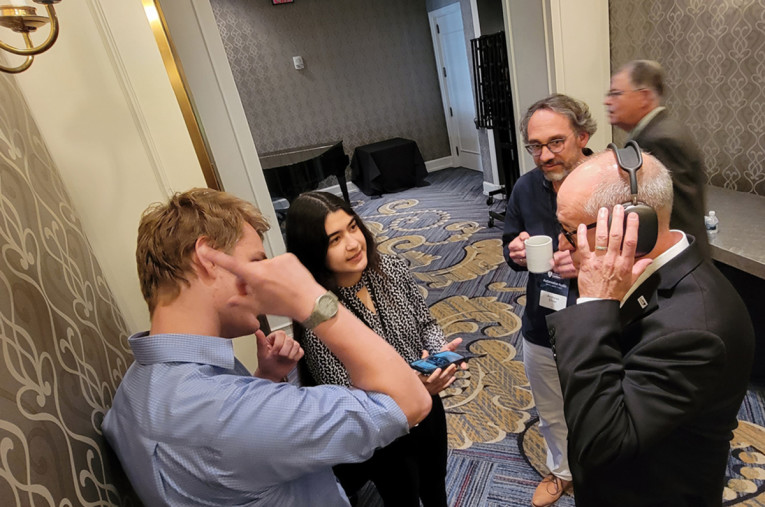
That very topic, continued into a panel discussion that focused on “Making Immersive Audio in Cars A Reality” (Photo 11), with content providers from mediaHYPERIUM, an OEM (Audi), a Tier One (Panasonic), and system providers (Dirac, Dolby, and Fraunhofer). The topic had others talking about it from the outside looking in, realizing that it’s no longer multichannel in a car, it’s multi-positional. Thoughts came up of where the audio processing would be taking place: in an amp, a cockpit domain controller, a module added to a bi-directional network, or in the cloud, looking at vehicle metadata and delivering the content in the optimal format. Also considered were the challenges for the content providers, the content licensees, and the hardware and firmware suppliers.
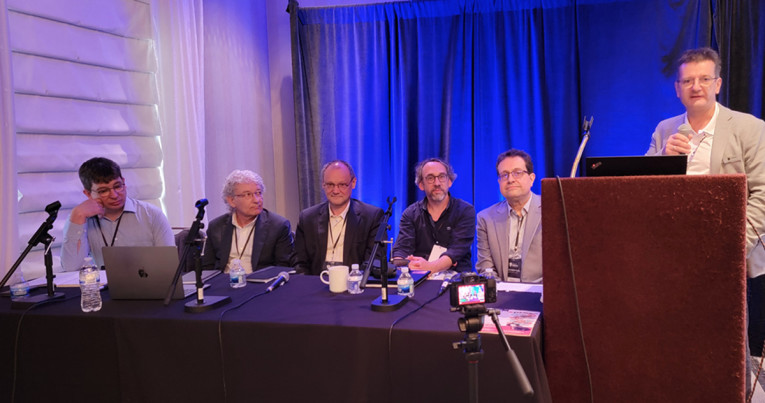
This was followed by a range of topics, with talks on evaluation of sound quality from New York University and from HEAD acoustics, and on achieving maximum audio processing throughput on the latest automotive chipsets from DSP Concepts. Also presented was a study on speech intelligibility performance of automotive voice microphones from Harman, an acoustic front-end to speech recognition in a vehicle from Blackberry QNX, and on acoustic event detection, seeing with sound: detection and localization of moving road participants with AI-based audio processing from Reality AI and Infineon.
The third day focused on airborne and vehicle noise and the audio system co-development. Presentations were given on AI in automotive audio, approaching dynamic driving sound design from Impulse Audio Lab, active sound design where noise, vibration and harshness (NVH) meets audio from Siemens and Neosonic, active noise cancellation (ANC) simulation considering the coupling effect of secondary sources from IAV, virtual pass-by noise sound synthesis from transfer path analysis data from Siemens, and on pop and burble triggered sounds (one example of a triggered sound that can generate excitement and provide a perception of powerfulness for the vehicle) from General Motors and Mueller-BBM (Photo 12). And, finally, there was an excellent full panel discussion on Noise and Sound with Siemen, Mentor, Harman, and Silentium covering the interaction of ANC, NVH, Acoustic Vehicle Alerting Systems (AVAS) and the sound system in cars, and how they can be simulated and integrated together.
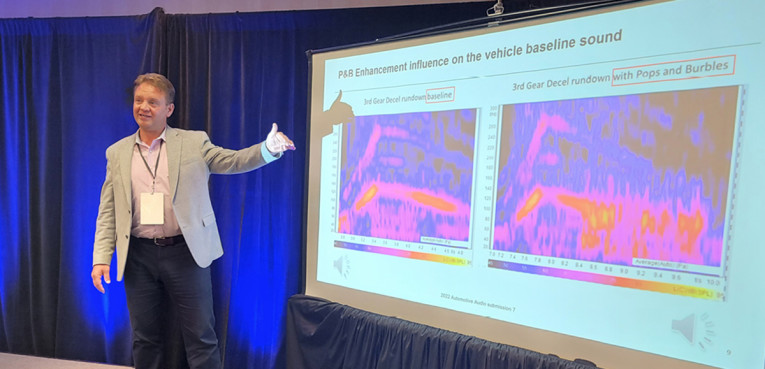
It could be said that change is slow to come, and then it comes all at once. The shift from two-channel and multichannel audio with simple sources to an immersive, multi-positioned audio, which is integrated with audio systems that manage and process noise and alerts, in parallel with the shift to personal sound zones, is ongoing and maturing rapidly.
The Demonstrations and the Displays
Walking through the exhibits and demonstrations, there was a wide range of types and opportunities to experience and learn (Photo 13). Audio Precision was on hand demonstrating best practices for getting trustworthy audio measurements in a vehicle as well as part of computer model verification in an APEI workshop (Photo 14). HEAD acoustics demonstrated the use of head-and-torso simulators (HATS) in recording how cars sound and how headphones and in-ears sound.


Using their MDAQS, a standardized ranking for timbre, immersiveness, and distortion of cars and earphones was possible through testing in a matter of minutes. HEAD acoustics also demonstrated the BHS II, a mobile headset for aurally accurate sound recordings. A set of headphones with little microphones on the outside of each ear cup is used. The microphones measure 360 degrees of detail around the head and the auralization of the measurement seemed very realistic. Across the hall, Panasonic was demonstrating in an Acura MDX Type S and a GMC Denali. Both utilized overhead speaker locations to create an immersive experience (Photo 15 and Photo 16).
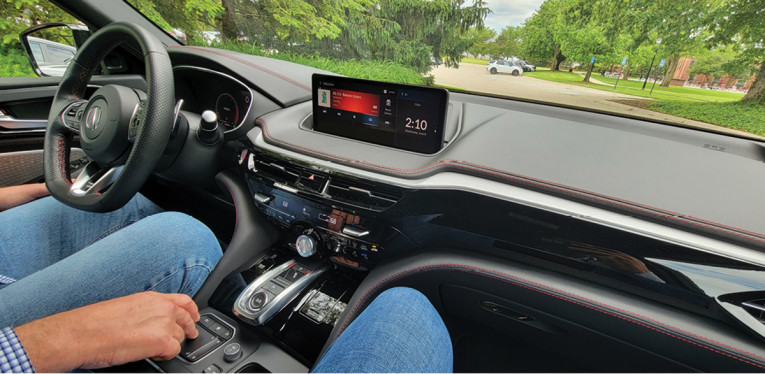

Next door to Panasonic, Dolby brought a Tesla Model X with Dolby Atmos automotive. The Model X had additional height speakers to allow for a true Atmos experience. And, Atmos encoded material was used, which did a very good job of exemplifying the immersive experience. Movie samples even outperformed the audio tracks in a fully-realized Atmos environment. On down the line, Dirac brought a Volvo XC60 T8 Recharge with the Bowers and Wilkins sound system. They added two additional height speakers where the grab handles were in the backseats. The speakers ended up giving a very good three-dimensional experience, while demonstrating their new-mixing technology, Virtuo. Using the common source of Spotify streaming material that wasn’t specifically mixed or altered, they flipped the Virtuo switch. The system felt like a spectral and spatial veil had been lifted. The fact that this technology could just be put into a car with little to no other special features makes it incredibly impressive and applicable across the industry.
Dirac’s neighbor at the show was Sennheiser, which was also using a Volvo XC60 Polestar with the Bowers and Wilkins sound system, in which they added Continental shakers in the headrests and a subwoofer shaker in the rear. The demonstration was of AMBEO immersive audio technology (Photo 17). The near-field headrest audio worked well for getting the backing vocals subtly placed right behind the listener and also creating listening zones for each passenger. Across the hall was Harman Automotive, where they brought a production Cadillac Escalade with the 36-speaker AKG Studio Reference sound system, which offered customizable passenger seat volume control and additional headrest mounted speakers for immersive, 360-degree sound throughout the cabin. AKG’s Acoustic Lens technology in the front of the Escalade’s IP speakers directed the sound smoothly toward the listener, while reducing the amount of sound reflected off of the windshield.

Fraunhofer demonstrated object-based audio as an immersive format and the use of automatic control of reverberation levels to improve the naturalness of the immersive sound formats. Next to them was Tymphany, partnering with DSP Concepts. Tymphany’s Automotive Audio Development Environment (AADE) vehicle buck was on display. Powered by DSP Concepts’ Audio Weaver, the AADE is a unique SUV-sized audio development tool used for creating new acoustic solutions, layouts, and proofs of concept. They demonstrated implementation examples, detailing voice recognition from multiple sources, telephony, sound zones, microphone performance, array studies, and object-based audio (OBA) (Photo 18).

That immersive audio technology has matured to its current levels and can be put into a car with little to no other special features makes it incredibly impressive and applicable in any vehicle. We can see that the benefits of immersive architectures, object-based audio, auralization and simulations are fully realized now in the automotive audio space, and that unique methods for controlling the sound-field and measuring will, and need to, evolve. aX
This article was originally published in audioXpress, September 2022
 About the Author
About the AuthorRoger Shively is a co-founder and principal of JJR Acoustics (Seattle, WA). He has more than 34 years of experience in engineering research and development, with significant experience in product realization and in launching new products at OEM manufacturers around the world. Before co-founding JJR Acoustics in 2011, Roger worked as chief engineer of Acoustic Systems as well as functional manager for North American and Asian engineering product development teams in the Automotive Division of Harman International Industries Inc., a journey that began in 1986. Roger received his degree in Acoustical Engineering from Purdue University in 1983, and finished post-graduate work in the field of finite element analysis. He is a member of the Audio Engineering Society (AES), Acoustical Society of America (ASA), and Society of Automotive Engineering (SAE). He has published numerous research papers and articles in the areas of transducers, automotive audio, psychoacoustics, and computer modeling. Roger also holds US and International Patents related to the design of advanced acoustic systems and applications, particularly in the field of automotive audio. Roger is Co-Chair of the AES Automotive Audio Technical Committee.



